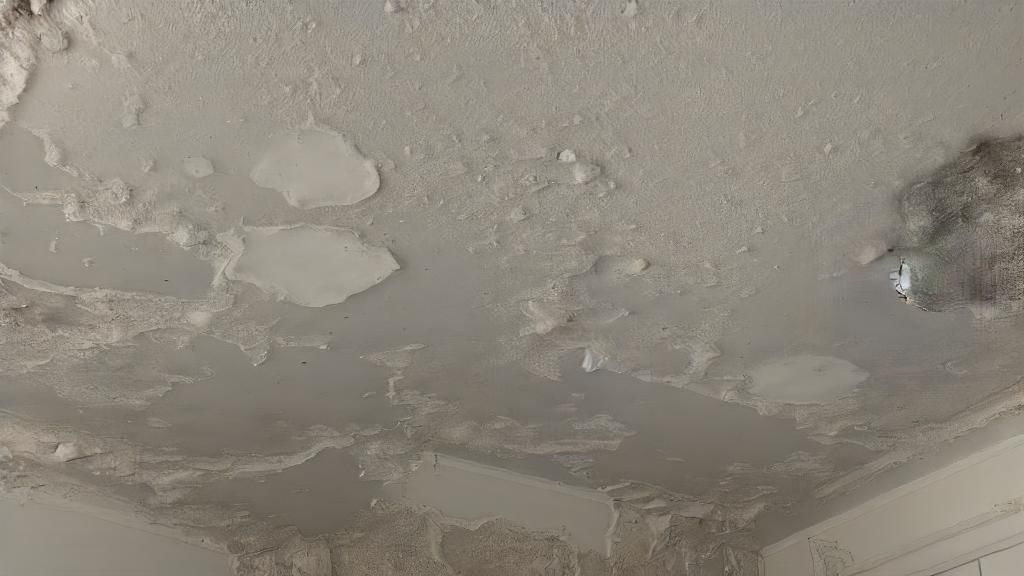Introduction
Water damage to ceilings can lead to the growth of mold, posing serious risks to both property and health. In this comprehensive guide, we’ll delve into the causes of water damage to ceilings, how to identify signs of mold growth, and effective methods for remediation.
Causes of Ceiling Water Damage
Roof Leaks: The Silent Culprit
Roof leaks are among the primary causes of water damage to ceilings. They often go unnoticed until significant damage has occurred. Causes of roof leaks include aging shingles, storm damage, cracked roof flashing, clogged gutters, chimney cracks, and faulty roof vents.
The Dangers Unveiled: Can a Roof Leak Cause Mold?
Aside from structural damage, a leaking roof creates an ideal environment for mold growth within just 24 hours. Mold can thrive between the roof and ceiling, causing hidden damage that may remain unnoticed until it becomes severe. Leaky roofs can also damage drywall, insulation, electrical fixtures, and ceiling joists, leading to expensive repairs and potential safety hazards.
Also Read: Water Damage Houston: Protecting Your Property Against Disaster
Health Effects of Mold Growth
Mold: A Silent Threat to Health
Mold growth not only damages property but also poses significant health risks. Mold spores can cause severe reactions upon inhalation or contact, particularly in immunocompromised individuals. Symptoms of mold exposure include respiratory issues, skin irritation, and even lung infections. Mold can spread through HVAC systems, contaminating indoor air and exacerbating health problems.
Identifying Signs of Ceiling Water Damage and Mold Growth
Visual Clues: Recognizing the Presence of Mold
Signs of ceiling water damage and mold growth include discoloration on ceilings, musty odors emanating from attics, visible cracking or bubbling paint, lumpy attic insulation, damp surfaces, and the sound of rushing water within walls or ceilings. Additionally, water may drip from the ceiling during severe leaks, especially during heavy rainfall or snowfall.
Differentiating Water Damage from Mold
Understanding the Differences
Water damage and mold can sometimes be confused, but there are key distinctions. Mold emits a musty or rotten odor, while water damage typically lacks an odor once fixed. Mold also has a damp and slimy texture, whereas water damage often results in bubbling surfaces. Mold growth occurs rapidly within 24-48 hours of water damage, emphasizing the importance of prompt remediation to prevent further spread.
Remediation of Ceiling Water Damage and Mold
Seeking Professional Assistance
For significant water damage and mold infestations exceeding 10 square feet, it’s crucial to enlist the help of certified mold testing and remediation professionals. These experts can identify sources of mold growth, assess the extent of the infestation, and recommend appropriate remediation measures to ensure complete removal.
DIY Remediation Guidelines
For minor leaks and mold infestations, DIY remediation is possible following these guidelines:
- Identify and repair the source of the leak, inspecting the property thoroughly for mold growth.
- Wear appropriate protective gear, including an N-95 respirator, gloves, and goggles, to avoid exposure to mold spores.
- Scrub mold from hard surfaces using soapy water or a bleach solution, ensuring proper ventilation during the process.
- Dispose of mold-infested materials that are difficult to clean, such as ceiling tiles or porous materials.
- Monitor the area for mold recurrence and ensure thorough drying to prevent future growth.
Prevention Tips for Water Damage and Mold Growth
Proactive Measures for a Mold-Free Environment
Preventing water damage and mold growth requires proactive measures such as:
- Promptly fixing leaks in roofs, plumbing, and walls.
- Cleaning and drying wet materials within 24-48 hours.
- Regularly maintaining roof gutters and drain lines to prevent obstructions.
- Keeping humidity levels low with dehumidifiers or air conditioners.
- Ensuring adequate ventilation in homes and redirecting exhaust fans and dryers outside.
- Conducting annual roof inspections to identify and address potential damage before it escalates.

Also Read: Water Damage Dallas: Understanding the Impact and Restoration Process
Conclusion
Water damage to ceilings can lead to the growth of mold, posing significant risks to both property and health. Prompt identification and remediation of ceiling water damage and mold growth are essential to mitigate further damage and safeguard occupants’ well-being. By understanding the causes, signs, and remediation methods outlined in this guide, property owners can effectively combat water damage ceiling mold and maintain a safe, healthy living environment.










